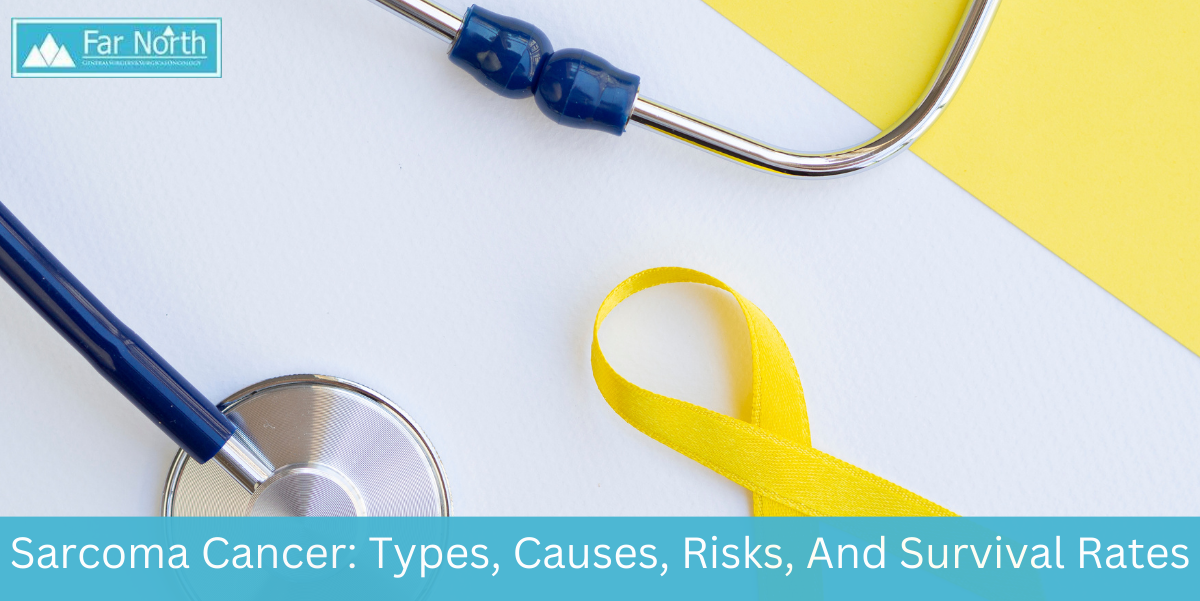


Sarcoma is a rare type of cancer that can manifest in various corners of the body, from bones to tissues. It is often overlooked, yet its impact on individuals and families can be profound. While sarcoma can occur at any stage, it tends to predominantly affect children, accounting for 15%- 20%, with just 1% in adults. This rarity can help alleviate potential anxiety in adult readers.
This blog explores the sarcoma cancer types, symptoms, potential causes, and risk factors and provides valuable information on managing your overall health.
Sarcoma is a rare cancerous tumor growing in bones and soft tissues that supports and surrounds other body structures. Sarcoma diagnosis often involves physical examination, X-rays, MRI scans, and a biopsy to detect cancerous cells. However, due to its rarity, it sometimes remains misdiagnosed. A study by the National Cancer Institute shows that about 12,000 soft tissue sarcomas and 3,000 bone sarcomas are diagnosed yearly in the U.S.
The two most common sarcoma cancer types are soft tissue and bone sarcoma.
Sarcomas, which originate in soft tissues such as arms, legs, and chest but can spread anywhere in the body, underscore the importance of early detection. Over 50 types of soft tissue sarcoma are found, and catching them before it goes out of hand improves the chances of successful treatment.
Most common types of soft tissue sarcoma:
Gastrointestinal Stromal Tumor (GIST): Begins in the gastrointestinal tract, inside the stomach.
Liposarcoma: Originates in the fatty tissue, usually affecting the trunk, limbs, and abdomen.
Leiomyosarcoma: Often begins in smooth muscle cells or organs found throughout the body.
Undifferentiated Pleomorphic Sarcoma (UPS): This typically occurs in the back of the abdomen, arms, or legs.
Synovial Sarcoma: Mostly seen in children and young adults, affecting cells around joints and tendons.
Malignant Peripheral Nerve Sheath Tumor (MPNST): This highly aggressive tumor occurs in the lining of nerves and deep tissues.
Bone sarcoma, a cancerous growth originating in bones, primarily affects individuals under 35.
Commonly, bone sarcoma include:
Chondrosarcoma: Occurs most often in the pelvis, hip, and shoulder. In some rare cases, it may also appear in the spine.
Osteosarcoma: It is most common in the pelvis, chest wall, and middle of the long bones in the legs.
Sarcoma symptoms may vary widely depending on the location and size of the tumor. If you notice any unusual symptoms, such as pain or a new lump, it's crucial to seek medical attention.
Here are some of the sarcoma symptoms to watch out for:
There isn't a precise study to show the exact sarcoma causes. However, some of the common sarcoma causes may include:
Chemical Exposure: Chemicals, such as Vinyl Chloride Monomer, used to make plastics, herbicides, and wood preservatives may increase the risk.
Radiation: People who have previously been treated using radiation therapy are more at risk of developing sarcoma symptoms.
Lymphedema: A long-term swelling in the arms or legs due to specific surgery or therapy can develop sarcoma.
Genetics: Certain inherited disorders and mutations, such as Li-Fraumeni syndrome, neurofibromatosis type 1, and retinoblastoma, tend to develop sarcoma cancer.
Preventive measures to reduce sarcoma cancer primarily focus on minimizing exposure to risk factors and maintaining a healthy lifestyle.
Here are some ways to manage sarcoma cancer risks:
Early detection and treatment are crucial in successfully treating and surviving sarcoma cancer. Survival rates may vary widely depending on the type and stage of the cancer. However, other factors, such as age, overall health, and how the tumor responds to the treatment, are also to be considered.
A study from the American Cancer Society based on the National Cancer Institute's SEER database data says the 5-year survival rate for all stages of sarcoma is over 65%.
While sarcoma remains rare, understanding the importance of early detection and knowing its causes, symptoms, and treatment may help you take preventive measures. Maintaining proper health care, lifestyle changes, and consistent medical checkups can significantly contribute to ensuring a better and extended life after treatment.
Far North Surgery at Anchorage, Alaska offers exceptional sarcoma cancer treatment options with suitable medical care and assistance. We specialize in diagnosing and treating sarcoma with a comprehensive approach that combines leading-edge technology and personalized care to help you or your loved ones find relief and regain quality of life.
Our experienced surgeon, Dr. Madhu Prasad, has been honored with the Best of Anchorage Awards. With his exceptional skills and expertise as a surgical oncologist for over 30 years, Dr. Prasad offers unmatched expertise and precision in sarcoma cancer treatment.
Contact us today if you are experiencing any of the above mentioned symptoms, or have been diagnosed with sarcoma cancer. Our team is always ready to assist you with the best available treatment.
Source: SFA, National Cancer Institute, American Cancer Society and WHO.